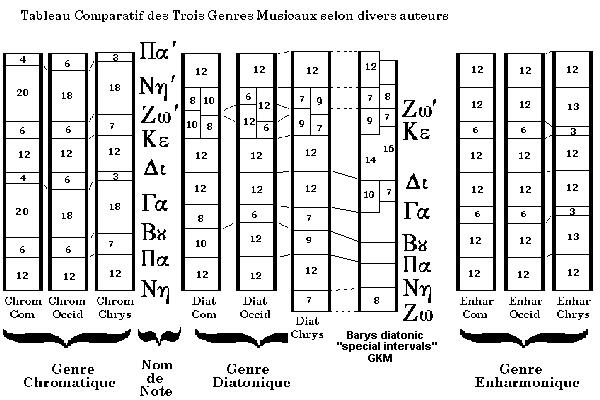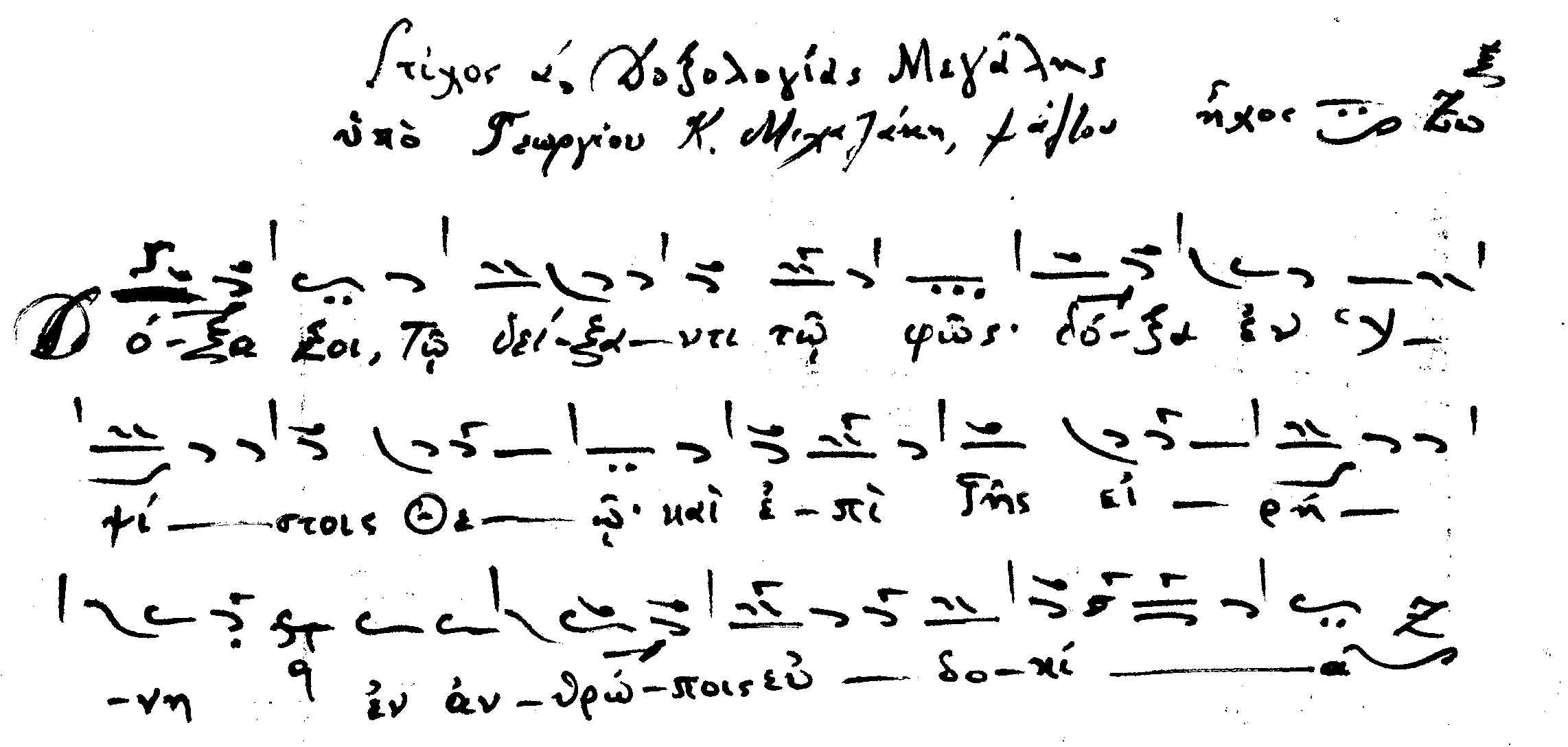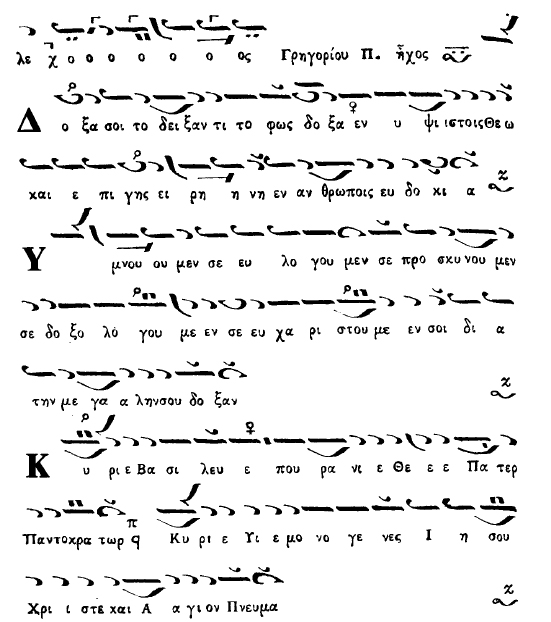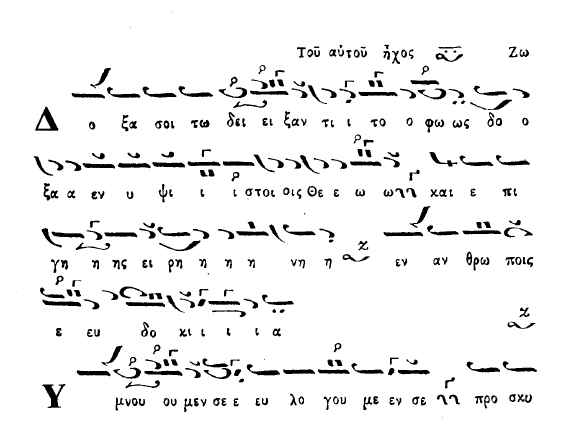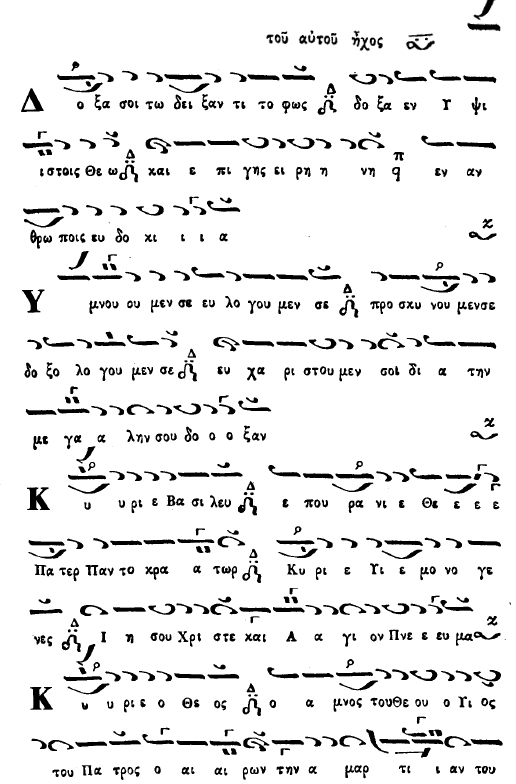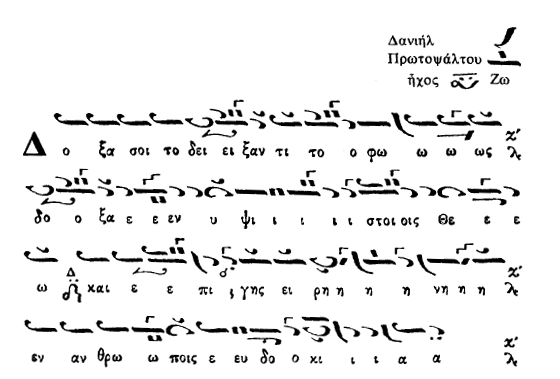1. Barys Diatonic (Normal or Simple or Haplos)
As given by the committee (1881):
?? 8
?? 12 ?a 10 ??? 8 Ga 12
?? 12 ?e
10 ??' (ascending)
?? 8
?? 12 ?a 10 ??? 8 Ga 12
?? 12 ?e
8 ??' (descending)
[------- a -------][--------- b -----------][------- c ------]
the same as given by Chrysanthos (1832):
?? 7
?? 12 ?a 9
??? 7 Ga
12 ??
12 ?e 9
??' (ascending)
?? 7
?? 12 ?a 9
??? 7 Ga
12 ??
12 ?e 7
??' (descending)
[------- a -------][--------- b ----------][------- c ------]
the same as given by S. Karas:
?? 8
?? 12 ?a 10 ??? 8 Ga 12
?? 10 ?e
12 ??' (ascending
and descending)
[---------- a ------------][----------- b ---------][- tone -]
Note the slightly flattened KE in Karas' scale.
2. Barys Diatonic with Perfect Fifth (Tetraphonos)
As given by S. Karas (K. Psaxos only gives the ascending scale):
Karas says that this is a mode without an ancient musical name (why?) and suggests
alternatives for the various branches. Nes (Normal), Ananes (Protovarys), Neanes
(Heptaphonos) etc. Gr. Stathis and his choir "Maistores" do Aanes. What is the truth?
The intervals may be the same theoretically but every other mode characteristic
is different.
S. Karas is the only one to support this claim. It is interesting that Chysanthos
describes Barys Heptaphonos as a chroa and not a mode (M. Theoretikon) and mentions
that the same chroa had been used before Daniel as well in Kalophonikoi Heirmoi.
See related disagreement on the pitch of Segah in Eastern music.
It doesn't mean ZW flat, it means that the intervals above ZW' become GA-DI-KE-ZW'
enharmonic.
Fr Dositheos, Stephanos Proussalis, L. Sfikas, Th. Stanitsas, L. Asteris, B. Emmanouilidis
(more?)
Ney taksim [
mp3, 705 Kb]
Ilahi [
mp3, 705. Kb]
Pesrev [
mp3, 705 Kb]
So the issue now is, is GA
in the above examples natural of sharp (or both depending on the phrase)?
To me, it sounds sharp, sharper than what we would do in First mode normally, but
not as sharp as in Barys Heptaphonos (where the melodic attraction pushes GA even
higher).
Another example of Barys Tetraphonos:
Polyeleos (psalm 44) "Logon Agathon" by Georgios of Crete ("Kres")
Score from Mousike
Pandekte, Patriarchate, Constantinople 1851
[
pdf, 1.5 Mb]
G. K. Michalakis [wma, 500 Kb]
Stephanos Prousalis [mp3, 1.7 Mb]
(broadcast on the radio by S. Kissas)
I still haven't had time to study the above performances,
compare and comment.
The same Polyeleos in different composition (by whom?) in the same mode,
chanted by Protopsaltis L. Sfikas
(broadcast on the radio by L. Angelopoulos and K. Angelidis)
L. Sfikas [
mp3, 2.9 Mb]
A beatiful interpretation!
GA seems
to be mostly sharp here too.
I have extracted a part (~7:17 min of the whole piece)
where Sfikas does two different GAs close to each other.
The first GA sounds natural, the second sounds sharp [mp3, 175 Kb].
Other recordings in Barys Diatonic for comparison:
"Akouson Thygater.."
Kalophonic Verse from Polyeleos of G. Kres
Barys Diatonic Mode
A. Karamanis' Choir.[
mp3, 800 Kb]
(offered by S. Gugushvili)
G. Xatzixronoglou.[
mp3, 2.5 Mb]
More research
S. Prousalis' Barys Diatonic in Plagal First Mode and Barys
Diatonic on its own.
[
mp3, 100Kb]
The first part (apechema-like) is cut out from the excerpt of Prousalis chanting
the Polyeleos "Douloi Kyrion" in Plagal First Mode, where is does a cadence on
low ZW. The second part is the beginning of "Logon Agathon" in Barys starting from
low ZW. ZW is in the same place in both cases.
L. Sfikas' Barys Tetraphonos in comparison with
maqam Bestenigar
a) I took a ney taksim in maqam Bestenigar and matched
it to L. Sfikas' recording of Polyeleos "Logon Agathon" in Barys Tetraphonos in
the ways shown below. I then superimposed the two melodies and listened to the result.
Barys Tetraphonos/Bestenigar comparison (Ottoman)
Matching GA - Cargah [
mp3, 700 Kb]
GA-DI seems to be identical.
Matching PA - Dugah [
mp3, 360 Kb]
PA-GA is inconsistent.
Matching ZW - Iraq [
mp3, 380 Kb]
Listen to the phrase of Barys Heptaphonos (where it moves around the high ZW' -
Evic).
Identical intervals and extremely similar phrasing.
b) I repeated the experiment with an Arabic song in maqam Bestenigar:
Barys Tetraphonos/Bestenigar comparison (Arabic)
Matching GA - Cargah [
mp3, 140 Kb]
The arabic clip was taken from
maqamworld.com .


Comments:
G. K. Michalakis:
(comments retrieved from the byzantinechant discussion forum archive)
On Gregorios' Doxology:
I just listened to the Doxologia by Stanitsas. His apechema is a STANDRAD Protobarys,
with NO special intervals.... PA is in its "Chrysanthos" diatonic position, beginning
to end. We do hear a nice Ni-Zo in the end. However, the choir does bring down the
"PA" a bit (not enough to my liking" in " anthropois eucokIIIIIIa". In the "Doxa
soi", they not only bring down Di, but Ga a bit a well. However, they can't keep
the "special intervals" throughout, and the piece does NOT sound like the Barys
of Sfikas or Proussalis... The determining factor is Pa and BOU, which they cannot
keep LOW enough at all times... and the piece is no longer the "special" barys,
and it is not the PROTOBARYS either (where Pa, Bou, Ga are in their NATURAL diatonic
positions, EXCEPT the conclusions on Zo, where we lower Pa slightly = special intervals).
So, the real question isn't about Ga diesis in itself, but about Ga diesis in RELATION
to ALL sorts of SHIFTED intervals....
So, those who focus on ONE note without realising the BEAUTIFUL intervals done by
MANY-shifted notes (which I have amply described, and all I got in return is "disagreement",
with NO one offering an example to accompany their "legetos" or xe-legetos or Ga-diesis
Karas et al affabulations = made-up stories) are missing out on this "serious, sweetly
tenebrous mode" which is of exceptional beauty and which NO instrument other than
human voice can express correctly.
Thank you for the Sfikas and Proussalis recordings... I'm not alone out there singing
the "special intervals". And listen to how Sfikas also "drags down" the UPPER Zo-Ni-Pa
intervals, when shifting to hepthphonos. The melodic line is that which we find
in plagal fourth and even in plagal first.. yet, the INTERVALS are different. Now,
if we need to go BEYOND that with NORMAL Pa intervals, the classical authors will
put a fthora of BOU on Zo (or Zo diatonic fthora on the UPPER UPPER Ga= Zo, thus
Bou = Ke, Pa= Di, etc), just like in the kallophonikos heirmos "Tas kakotheisas" by Anonymos, page 143. Also note in this composition, the initial syneptegmenos
"shifted" measures that fall back onto their feet (just like "Anympheute" in "Ti
hypermacho"). Pringos and Stanitsas do not maintain special intervals throughout
their Barys, so I wouldn't use them as references for either pure probarys vs. special
intervals barys. As for all the other psaltis, as far as Barys is concerned, "if
it isn't Giannis, it's Giannakis"...
+++
On instrumental samples:
In all these pieces, we are NOT dealing with POTOBARYS and we are NOT dealing with
"special intervals". We are dealing with "sabach or even ousak" that just simply
go down to Zo. The Ni and PA are in their NORMAL diatonic positions. Di is lowered
to GA in its normal diatonic position. Bou is not too raised, so we're not really
in Spatheion. for instance:
bestenegar_pesrev: the initial long note
is our GA.... Bou here is a bit high, and we have spatheion in just one measure...
Then Bou is normal, PA in its NORMAL (high) diatonic position...
Cemil-bestenigar-pesrev: Starting from ga,
we hear a DI and Ke enharmonic all the way to Zo... then back to Ga, with Di later
on hyphesis... and the melody stagnates on Ga (polar note), with quick passage to
diatonic Pa, and then diatonic Zo. The string and bow do Ga di ga bou pa, typical
of the FIRST MODE (the one most of you like calling "diphonos"... the PA is in its
position...), and typical of the line Shota scanned and put up.
To my ears, most of these musicians are quite coherent, (except for ney_bestenegar_taqsim).
But their mode has NOTHING to do with Barys as sung by Sfikas, and Proussalis, Tsolakidis
at times, and Xerodemas. I feel that we should NOT mix up VOCAL with instrumental
music... The ONLY corrections that need to be made in psaltiki are those of all
contemporary and auto-didact psaltis and their followers, who should listen to old
recordings and correct THEIR perception of psaltiki... the Turks know what their
doing with their instruments... so do the Greeks... but the psaltis should learn
from CREDIBLE psaltis, and not
from some instrument..
++++
On Barys Diatonikos vs. Legetos (part I):
I just finished listening to Stephanos Proussalis: EXCELLENT, EXCELLENT.. hyphos,
chronos, EVRYTHING... even good Barys "special" intervals. Does anyone know who
he learned from? He sounds very much like the monk Dositheos. And Sfikas... yes,
we have EXCELLENCE here as well... BEAUTIFUL "special" intervals. Now, what do the
interpretations of these two psalits, (and you may add mine, as well) have to do
with either LEGETOS or all the other "theories" running around, especially from
Karas et al.
I get the impression that ONLY occidental musicians can understand Karas' "descriptions".
Andrea, for instance, would agree that Sfikas' intervals are good, special intervals.
She was the one who actually sat down and demonstrated to me on paper what I was
doing., But I really DON'T understand how she agrees with Karas' descriptions....
As for the Apostolos "spatheion Ga, Kliton Di", she had NEVER read of it anywhere...
not even in Karas' manual... So, I put up one of the messages I had posted in the
past to describe the "special intervals" of Barys diatonikos. There are so many
barys diatonikos schools that one has to make one's proper "synthesis".
There are those who sing as LEGETOS at Zo, and I will not even quote them, but they
have had traditional and respectable teachers (I was referring to Andrea). But acoustically,
they don't manage to convince me. Then there are those that pull down Di to Ga,
and keep Pa in place. They either do an EPITROPI PA, close so Ni, in turn close
to Zo, OR they do a CHRYSANTHOS PA, quite distant from Ni, this Ni being still close
to Zo.
I guess that the issue about Ke is resolved. No one agrees with Stanitsas, and you'll
find that Iakovos (Nafpliotis) and Priggos are quite similar (this was demonstrated
by Dimitrios' comparisons). What I'm about to describe is none of all this, regardless
of my admiration for Iakovos.
The following is my "Synthesis" after having heard Parallagi [VERY IMPORTANT] on
bits and pieces of Barys by the Protocanonarchos [student of Iakovos, Binakis AND
Kamarados], as well as my grand (meaning "great") uncle Nicolaos Xirodimas (his
son, now in his late 60's, would sing with Beloussis at Ag. Panteleimon Acharnon).
By Epitropi vs. Chrysanthos, I was referring to MY visual conception of the scale.
Ioannis (Arvanitis) and Panayiotis (Papadimitriou) have now demonstrated the SIMILARITIES
of the two scales REGARDLESS of the visual and numeric differences which describe
the SAME FREQUENCIES in DIFFERENT manner. Anyhow, I insist that the Chrysanthos
diagram helps me do CORRECT intervals in terms of its "psychological effect", which
is "different" from that of the "epitropi".....The Chrysanthos diagram helps me
do almost "Didymos" intervals, as Panayiotis (Papadimitriou) demonstrated. The Epitropi
diagram, on the other hand, tends to push me into doing "piano" intervals...
+++
On Barys Diatonikos vs. Legetos (part II):
I just came off the line with Andrea. She really enjoyed the Barys by Proussaslis
(especially his hyphos = like Iakovos) and Sfikas (for the clarity of the intervals).
She mentioned a "high Ga towards Di", so I guess we're in the theory I was mentioning.
SOME intervals may sound like those of Legetos, but Barys is NOT EXACTLY legetos,
she insisted. She just discovered Feihrouz singing legatos (in some folk song) and
was astounded with the INTERVAL precision as well as difference as to most Greek
psaltis, and said that Karas' description is not too bad. Ibrahim does the same
intervals. And I recall that Bardas and I had some trouble "tuning into each other's
legetos after many years of separation. Bardas does, most of the time, those particular
intervals of legetos that Faihrouz and Ibrahim do.
Bou = ison. Di is QUITE HIGH, and Ke seems to be lowered, and ZO is DIATONIC and
quite high (at all times, no Zo hyphesis). In the lower part, Pa is close to Bou
(because it is naturally high", yet NI is slightly "uplifted" = does not sound in
its plagal fourth position, when we transiently go past it. Zo is STABLE in ascent
AND descent, with NO hyphesis. You can hear all this in Bardas' chanting of "Anoixo
to stoma mou" or in "Ek neotitos mou" under "kyr Bardas" in Montral Psaltiki in
www.graeca.mrezha.net/upload/
Somewhere along the line we all "mess him up", because we all have OTHER legetos
in our heads... but there are parts where he applies those exact intervals (especially
in the very beginning of each hymn). I admit that those intervals sound a bit "funny" as compared to those of Tsolakidis, and we do not have much of legetos by Iakovos
for comparison. We know, however, that his plagal fourth Di is a bit higher as compared
to a First mode Di (listen to Mi apostrepsis"). So, this INTERVAL stability in legetos,
with a HIGH di and a slightly lowered Ke seems to have pleased Andrea enormously,
for she "rediscovers" legetos.... in a manner that corresponds well to the descriptions
given by Karas.....
Use of "syneptigmenos" in OTHER languages: As for rhythmos, in Greek we tend to
prolong the accentuated syllable a bit more than the non accentuated syllable in
Heirmologic chanting. In Andrea's native language, Hungarian, it seems that accentuated
syllables should NOT be prolonged, and that iambic type of distribution may be better
suited than trochaios in "thesis to thesis" counting.
About Barys diatonic [Sfikas]: Andrea said that the Sfikas intervals are those she
had learnt from Angelopoulos... now, if anyone has EBX chanting Barys diatonikos,
I'd like to verify the connection between theory and practice.. She'll have to listen
to all this much more carefully so as to come up with some "interval diagram", because
all this was discussed over the phone...
Since Dimitrios mentioned a "high Ga" and so did she, I thought I'd share all this
with you. I personally hear Pa-bou-Ga-di ALL downshifted.... this doesn't really
make Ga sharp... We had come up with that diagram together, but she'd like to rehear
things and come up with something more concrete.... To my ears, the Pa-bou-Ga-di
ALL downshifted scale describes very well all that is happening in Barys diatonikos
"special intervals" and explains what happens when ison is brought to normal diatonic
Pa so as to make "protobarys".
++++
G. K. Michalakis
Koinonikon "Eis Mnemosynon" (of Tuesday), Petros Lambadarios, Mode Barys Diatonic
[
mp3,
6 Mb]
... with "special" Barys intervals.
From memory, Chatzimarkos does a very nice "Barys diatonikos" in the Psalmos 50
with "Anastas of Ihsous" as well... I hope someone can find this recording of his...
the situation is similar: The ison remains on Zo diatonic. The Heptophonic Zo becomes
ENARMONIC, with Ano Ni and Ano Pa lowered a bit ("special interval" as applied to
the octave). Coming back down, the Di is in HYPHESIS, and the Ga is Lower than diatonic,
the Bou lower than diatonic, the Pa lower than diatonic, the Ni more or les in its
position, Zo diatonic in its position...("special intervals"). Listen to the line
"Eis mnimosinon aiOOOOOOOOOOOnion estai dikaios, Alliluia".
G. K. Michalakis
L. Asteris, Protopsaltis of the Great Church (2005) [
rm, 1.9 Mb]
In the line "oi ta cherouBEIIIIIIIM", in its ending melodic formula, we hear the
"special intervals". During the Orthros, all of the recorded psaltis do a NICE Ga
DI (LARGE) in the Enarmonios pieces that precede this hymn, yet the ALL mess up
the KE (TOO low for enarmonios).
According to Andrea (Atlanti): Karas is perhaps correct about Naos but quite correct
about Barys being almost equal to legetos at lower "basis". According to me and
from what I've understood from Chatzitheodoros, the use of put second mode fthora
is for "approximation" purposes... and I tend to agree much more with him... and
I add, Barys is NOT legetos from a lower Basis. Andrea admits that she's never heard
the "special intervals" as I do them THROUGHOUT a papadic melos, yet she DOES agree
that those are the VERY intervals when I sing something like "eleison me o Theos" = Psalm 50...
My opinion is that we have "remnants" of the special intervals in various places,
and that, because it is quite hard to do them throughout a piece, most will chant
papadic barys diatonikos as they would a legetos, or as second mode or even as a
first mode. It's true that in "ton despotin", = where the entry of the archieureus
" = represents the entry of Christ into his "ship" which is the Church = where the
archieureus should be "taking kairos" immediately, but I guess this has been broken
into two: eis polla eti for the entry, and "ton despotin" for kairos ... "anothen" for the amphia vesting", Iakovos chants the "deuteros variant" (his Zo Ke Di is
almost like Di Ga Bou of second mode), with non chromatic Pa = Ke (His pa is NOT
lowered at all)... But I've heard the remnant "special intervals" in Tsolakidis'
chantng. Thus far, only Ioannis has ventured a bit on all my Barys diatonikos descriptions,
and I have yet to hear any serious debate on these descriptions of what happens
at the lower pentachord (pa, bou Ga, Di, ALL shifted a bit lower...) .
 On "special intervals":
On "special intervals":
Intonation (Apechema). Starts at NI; Chrysanthos 12 to PA. Chrysanthos GA.
Return to Chrysanthos BOY. Return to Chrysanthos Pa. Go to Bou, but slightly diminished.
return to PA, but slightly diminished, as if you were doing an Epitropi Pa (Lower
than First mode diatonic Chrysanthos Pa). Bring Ni bit close to this Pa. then do
a Chrysanthos Zo. Thus how, PA-Bou isn't really diminished: It's just that the whole
Di Ga BOU PA is "brought down in a particular way. So, this is what I think Chatzitheodoros
means, when he says that the Fthora of 2nd mode is there because barys diatonickos
"sounds a bit like second mode", without it being so. In the meantime, the lowered
Ga is not as much lowered as the Pa, and Bou Ga might seem slightly greater than
usual. Perhaps this explains Ephesios' use of the second mode fthora on Pa on short
passages, so that one will not lower the Ga disproportionately. None of the all
the teachers I did parallagi called the Zo by any other name, fthora or no fthora.
That's interesting. My guess is that, with time, some probably started putting PA
as an isson instead of ZO. In such a case, we cannot continue with a lowered pa,
and the whole thing turns into a "first mode" Pa, and it's only the Di, all alone,
that is lowered, giving a "pathitikos" instead of "barys special intervals".
I'm sending you a sample of these two compositions, where I try to respect, at least
to a minimum, the use of the fthoras, which, of course, have nothing to do with
second mode. (Back then, I did various interpretations of "Ton Despotin" either
alternating of the fthores so as to get "special" vs "diatonic" or disregarding
them and doing "special" throughout. The paleographers noted that there is NO fthora
in the original manuscripts.... On the other hand, I send you as well a "home choir
recording" I put together a couple of months ago (it' only lately that I'm beginning
to recover a bit of my voice. So, I'm like an old, badly tuned violin, especially
in TEMPO. anyhow, the idea here is that I did NOT try to go into first mode. I kept
Zo as isson throughout.
TonDespotinChourmouzios-Excerpt-_HomeSoloRVRB.mp3
TonDespotinChroumouziosNoFthora._HomeSoloRVRB.mp3
TonDespotinKonstantinou_Anthologia_HomeSoloRVRB.mp3
Now, I guess things start to become clearer. If you keep isson a Zo, you can pull
your Pa a bit down, and you can do this THROUGHOUT the piece, fthora or no fthora
(which, I bet isn't absolutely necessary according to palaeography: please let me
know. I did not do that for ton Despotin, but it is possible. I tried doing it for
the KOINONIKON Petrou, Tuesdays, as it is written in "Mousikos Thesauros" edited
by Nectarios Monachos, 1931.
+++
About his own composition and sound example:
I thank Dimitrios for putting up the barys diatonikos file. Here is some IMPORTANT
information concerning the file. Composition: it is MY won. I try to show what Rhythmic
emphasis is, and how toobtain some COMPOSITIONAL Rhythmic regularity.
Interpretations are of 3 "types". Protobarys, Spatheion and Barys Diatonikos. The
experiment was as follows: Using the SAME score, to try and determine if there are
any DIFFERENCES or similarities. Firstly, the COMPOSITION is almost INCOMPATIBLE
with protobarys. In Protobarys, we chant FIRST mode hiermologic, with Pa Di as dominant
notes (and not Pa Ga, as in this case). Anyhow, I just wanted to try and demonstrate
the difference between Ga-DI spatheion, first mode, and "special intervals". For
Protobarys, I used an ison on PA... For Spatheion, ison on Pa as well. For Barys
diatonikos, ison on Zo.
D. Koubaroulis:
You are talking hypothetically now. There is no ison in the recording.
G. K. Michalakis:
As a matter of fact, I did use ison in one ear, but it is not in the recording.
when I do interval experiments, the ISON must be there, as it is in Church, otherwise
things aren't that "comparable". I used Occidental notes, so the Zo-Pa isn't exactly
psaltic... Isson allows one to find the CORRECT harmonics (chord fractions that
will give the LEAST dissonance... Thus how, when isson is on Ni, Di is a bit higher
so as to get a good fifth. When isson is Pa, Di is a bit lower, and the Fifth is
Ke. Thus, for a SAME PA, DI is DIFFERENT depending on whether we're in first mode
of plagal first mode... The same applies to BARYS with isson on Zo... placing an
isson on Pa will change MANY intervals.. ..Anyhow..
For the first two cases [Protobarys and Spatheion], Ke should be HIGH (although
I do mess it up a bit on the spatheion... it needs to be a bit higher, toward the
Zo hyphesis). Pa is in its isson position. Zo is in its diatonic position. This
Zo sounds higher than the Barys diatonic Zo.... Andrea insists that it shouldn't
be, even in first mode.
D. Koubaroulis:
Andrea is right. ZW diatonic is ZW diatonic. Its position doesn't change. It is
the basis of the mode!
G. K. Michalakis:
In Protobarys, the Basis is mainly Pa... so is the basis = Pa in Kyrie ekekraxa
and, recall, I DON'T change the ison from Pa to Zo in the "eisakouson mOUOUOUOU"....
Ibid for "spatheion". the ison is NOT Zo...
In first mode kekragarion ending on Zo, arabs chant this a bit lower, Greeks a bit
higher (what I'm actually doing).. She insists that it's an occidental Zo... I treat
it "elxeis"... Please tell me what you all think about this.
D. Koubaroulis:
I don't understand what is an "occidental Zo" and what it means to "treat it "elxeis"".
There is no such thing as elxis on the base note of the mode.
G. K. Michalakis:
Occidental Zo is a bit higher for an equal Pa...
I'm dealing with FIRST MODE with ison on PA... I repeat, I'm dealing with FIRST
MODE with ison on PA
D. Koubaroulis:
In any case why are you doing Protobarys as a Greek and Barys as an Arab?? :)
G. K. Michalakis:
I don't know, Dimitris. the whole thing is an experiment. I've noticed that there
are two different Zos from time to time. Spontaneously, I do a higher Zo in
first mode vs. Barys. What I'm trying to figure out is... is it all right or is
it not? To answer my question, try doing ison on Pa continuously. If it sounds "ackward",
maybe I should be doing a lower Zo. After some thought and listening to Iakovos
and Dositheos, I realize that psaltic Zo in fist mode should be LOW. So, my "occidental" Zo in Fisrt mode is an error.....
In Barys diatonikos, I try to do the Special intervals. We should try figuring out
if the PA I do here is in the same position as the PA in protobarys and spatheion.
D. Koubaroulis:
About Barys diatonikos: I haven't paid attention to PA yet, from a first listen
it sounds the same throughout, I will listen more carefully. For the moment let's
concentrate on what you do to ZW and GA. Basically you do what I observed and reported
but well, you cheat! Instead of keeping ZW
the same in all branches of Barys and lowering or raising GA accordingly (to 8 or
12 moria in terms of the BOY-GA interval), you keep GA the
same and you move (in particular you lower) ZW so that the ZW-GA interval sounds
like a perfect fifth (to satisfy Psaxos' argument).
G. K. Michalakis:
Notice that the Ni Zo is quite "large", and that Zo is quite "low", just like a
GA BOY in legetos.
D. Koubaroulis:
Yes...only that you lower it too much in my opinion. It sounds almost enharmonic.
By the way, the PA-NH-ZW = DI-GA-BOY analogy is
correct and it is witnessed by theoreticians of the old method as well (B. Stephanides,
1819 is an example). Panagiotidis agrees as well.
Stanitsas disagrees in his interview, who knows why.. maybe because he doesn' t
like Karas.
G. K. Michalakis:
For Andrea = Di Ga bou, and Tsolakidis does a nice large Ga bou in legetos, so I
guess the ENDING(lower zone) might sound like legetos, but certainly not the upper
zone... Do I "cheat" in Eleison me o theos as well??? THAT's the real standard,
for me (something I learned well by heart)..
G. K. Michalakis:
Finally, the Eleison me O Theos is done by heart, and is my "interval reference" for Barys diatonikos.
D. Koubaroulis:
It sounds good, better than the other examples.
G. K. Michalakis:
Aha... It's because I'm really not thinking, and just applying everything I've learned..
D. Koubaroulis:
I think this is because in fast chants you don't get to spend too much time on controversial
intervals and they don't stick out that much. Not saying that the
other recordings are bad, but I think they have issues.
G. K. Michalakis:
You're absolutely correct...
G. K. Michalakis:
Try and figure out if I do a "down shifted" "pa-Bou-Ga-Di", in which case the Ga-Pa
is not the same as the Ga-Pa of Spatheion (= Bestengar, according to me). If you
find no differences, then we may say that even thinking differently and putting
the isson in different postions doesn't change much.
D. Koubaroulis:
Although I haven't paid attention to PA, it seems to me logical to
lower PA and BOY since you have lowered ZW in the first place. So your issue is
ZW and not lowering PA and BOY.
G. K. Michalakis:
MMMM... let's take the one we agree on, eleison me O Theos.. does the Ni PA sound
like that of first mode. Are MOST of the notes in the SAME position as first mode,
or are they slightly lower. In this piece, I honestly don't feel that it is only
Zo that is "quite low"... Focus in on the PA and try telling me what happens, please.
D. Koubaroulis:
I am not sure about that yet.
G. K. Michalakis:
I feel that barys diatonikos has "special" intervals and that it is not exactly
spatheion melody.
D. Koubaroulis:
Nobody said it is spatheion.
G. K. Michalakis:
The instrumental recordings You put up sound quite spatheion to me... we may wish
to push up bou a bit, but all in all, they are "first mode pathitikos", which eventually
drop to Zo. This means that EVERYTHING is equal to first mode except Di ,and perhaps
the Bou. I'm just describing what I heard.
D. Koubaroulis:
Gregorios' doxology is indicated by a 4up sign (therefore Tetraphonos) and has DI
flat (what does this flat mean?). If you consider that the same as First
mode Diphonos (what you call spatheion) then we hear different things or Stanitsas
is wrong in his interpretation of GA-DI in the IBM recording.
G. K. Michalakis:
NO... I'm trying to prove the OPPOSITE: I'm trying to prove that the BARYS diatonikos
has NOTHING to do with the instrumental version you've put up which are CLOSER to first mode pathitikos.
I'm trying to prove that the for a SAME ZO, the PA is NOT the same between Spatheion
= first and Barys diatonikos. But since instruments cannot distinguish between the
two, they play the SAME pa.
And I'm trying to demonstrate that what I chant in "eleison me" was not learnt from
some instrument, and that names such as Betang.. have NOTHING to do with what one
can learn form a teacher's mouth. What do Stanitsas' intervals have to do with the
two other superb interval interpretations you put up???? NOTHING!!!
All in all: I feel that one should distinguish between Protobarys, Spatheion (Pathitikos)
and special intervals. The latter are possible ONLY if one maintains isson on ZO
throughout the piece. Draw a diagram according to Chrysanthos. Take DI, Ga, Bou
PA and push them all down about 2 or 3units (out of 12/68). Push Ga just a bit up
(one or two units = ALMOST its initial position). Push Ni JUST a bit up (one or
two units). These are the SPECIAL intervals. The fthora of Di on Pa can be explained
by a large BOU GA interval, which sounds SHARP, thus satisfying Ephesios’ writings. Ni Zo is large, even without moving the Ni, if one uses the Chrysanthos
diagram, and it thus sounds like Legetos, satisfying the Legetos theory. Ga Di is
small, satisfying the hyphesis on Di theories. Yet, this scale is NEITHER protobarys
NOR spatheion.
Here is the diagram that Georgios refers to (click for larger):
